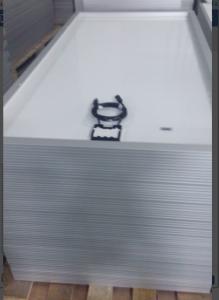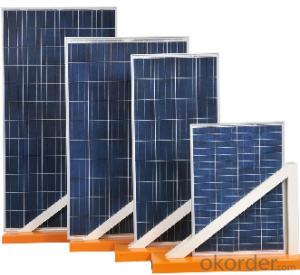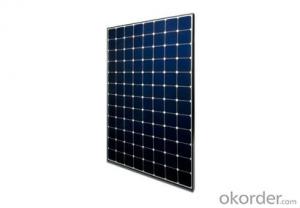Government Subsidized Solar Panels - Monocrystalline Solar Module 220W with Outstanding Quality and Price
- Loading Port:
- Shanghai
- Payment Terms:
- TT OR LC
- Min Order Qty:
- 100 watt
- Supply Capability:
- 10000 watt/month
OKorder Service Pledge
OKorder Financial Service
You Might Also Like
Specification
Monocrystalline Solar Module 220W with Outstanding Quality and Price
Production Description
solar cell (or a "photovoltaic" cell) is a device that converts photons from the sun (solar light) into electricity.
In general, a solar cell that includes both solar and nonsolar sources of light (such as photons from incandescent bulbs) is termed a photovoltaic cell.
Fundamentally, the device needs to fulfill only two functions: photogeneration of charge carriers (electrons and holes) in a light-absorbing material, and separation of the charge carriers to a conductive contact that will transmit the electricity.
This conversion is called the photovoltaic effect, and the field of research related to solar cells is known as photovoltaics.
Solar cells have many applications.
Solar cells are described as being photovoltaic irrespective of whether the source is sunlight or an artificial light. They are used as a photodetector (for example infrared detectors), detecting light or otherelectromagnetic radiation near the visible range, or measuring light intensity.
a solar thermal collector supplies heat by absorbing sunlight, for the purpose of either direct heating or indirect electrical power generation from heat. A "photoelectrolytic cell" (photoelectrochemical cell), on the other hand, refers either to a type of photovoltaic cell (like that developed by Edmond Becquerel and modern dye-sensitized solar cells), or to a device that splits water directly into hydrogen and oxygen using only solar illumination.
Application
remote area home system
earth orbiting satellites
consumer system
water pumping system
residential
commercial
industrial
rooftop
Product Feature
Higer convension than the poly solar module
12 years product warranty
A grade solar panel with good surface looking
EVA tempered glass TPT
MC4 connecter
Package
24pcs into one carton 312pcs into a 20 foot container.
- Q: Can solar panels be leased or financed?
- Yes, solar panels can be leased or financed. Many companies offer leasing options where homeowners can rent solar panels for a monthly fee. Additionally, there are various financing options available, including loans and power purchase agreements, which allow homeowners to pay off the cost of solar panels over time.
- Q: how much energy does a kilowatt solar panel produce in a year? (average)
- You would be amazed how often I have answered this question. The answer is that it depends on your latitude and local weather . Let's see if I can give you enough information so that you can determine the answer for yourself. A kW solar panel is rated at kW when it is exposed to a solar flux of kW/m^2 (called a peak sun hour). There are readily available tables of effective peak sun hours per day by city (see Reference ). Let's use Fairbanks, AK as an example (it is the first line of the table). Fairbanks get an average of 3.99 of peak sun hours per day on average. So your panel would produce 3.99 kW*hr per day on average.
- Q: I'm going to pitch an idead to my school about switching to Solar Energy. What are positive and negative effects of the solar panels?Also what is the cost for installing them into a highschool?How much would the electricity bill decline afterwards?
- If you hope to get a solar panel that can run appliances and air conditioning.. then you are not even close to being realistic about what solar panels can do. If you really want to install a solar panel array on your home, then you need to talk to a company in your area that designes and installes them because every installation is different.. so you won't get an answer here on Yahoo. You can expect to spend $20,000 to $30,000 that will provide enough solar power for the average home.
- Q: Can solar panels be installed on a gas station or fueling facility?
- Yes, solar panels can be installed on a gas station or fueling facility. In fact, many gas stations and fueling facilities have started installing solar panels to generate renewable energy to power their operations. This not only helps reduce their carbon footprint but also cuts down on electricity costs.
- Q: Do solar panels require a battery?
- No, solar panels do not require a battery. They generate electricity directly from sunlight and can feed the excess energy back into the grid. However, a battery can be used to store the excess energy for later use when the sun isn't shining.
- Q: Can solar panels be used for powering outdoor recreational vehicles?
- Yes, solar panels can be used for powering outdoor recreational vehicles. They provide a renewable and sustainable source of energy that can charge the batteries of RVs, campers, and other outdoor vehicles. Solar panels can generate electricity during daylight hours, allowing for off-grid power supply and reducing the reliance on traditional fuel sources.
- Q: Hello, i want to ask whether if you could make an improvised version of solar panel made from an old CD or DVD?Is it possible or not?Please give me steps on how to make one if you know(put aside the one you see on quot;ehow: How to Make a Solar Panel From CDswhich says a bit confusing for me :( )Why not?
- A solar electric panel? No. Solar electric cells, or more properly photovoltiac (PV) cells, are made from specially prepared (doped) wafers of silicon, much like transistors and diodes. CDs and DVDs are made from plastic plated with aluminum. They don't have anything to do with each other. Of course you can make a reflector out of CDs or DVDs, and you could use a bunch of them to focus sunlight on a water tank or something - this is called solar thermal generation. (That's what that ehow page is talking about, not generating electricity.) But there are much better things to use for mirrors.
- Q: Could you throw some long scientific words in with your answer so I can impress my teacher, I'm looking to expand my scientific vocab. Thanks
- Solar panels are a generic term for any type of solar collecting panel. There are two major types: Photovoltaic uses substances that turn the incoming radiation directly into electricity. Usually you have to have direct sunlight (no clouds) for this to work well. Solar thermal is also used in a lot of areas. Here the radiation is used to heat a circulating fluid (often water directly), and then that is either used directly, or it's used for heat exchange with a heat pump or a boiler system. Solar thermal can collect significant heat even on a cloudy day. So a solar panel could be made of photovoltaic panels, but it doesn't have to be.
- Q: Has anyone had any experience building their own solar panels for home use? I have seen on the news lately that people are utilizing solar panels to power their hot water heaters to save on their power bill.
- I okorder /. It's a pretty basic article that gives you the gist of it.
- Q: Pros and Cons if I get solar panels?
- If solar panels were cost effective we would all be buying them and you would see them on the roof of every home. They are not. It is cheaper to buy electricity from the electric utility company.
Send your message to us
Government Subsidized Solar Panels - Monocrystalline Solar Module 220W with Outstanding Quality and Price
- Loading Port:
- Shanghai
- Payment Terms:
- TT OR LC
- Min Order Qty:
- 100 watt
- Supply Capability:
- 10000 watt/month
OKorder Service Pledge
OKorder Financial Service
Similar products
Hot products
Hot Searches


























